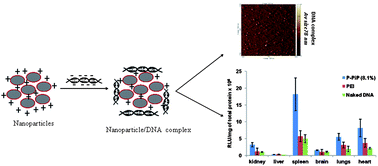Polyethylenimine-polyethyleneglycol-bis(aminoethylphosphate) nanoparticles mediated efficient DNA and siRNA transfection in mammalian cells
Abstract
In an attempt to circumvent toxic effects of branched polyethylenimine (

* Corresponding authors
a CSIR-Institute of Genomics and Integrative Biology, Delhi University Campus, Mall Road, Delhi-110 007, India
b
CSIR-Indian Institute of Toxicology Research, M. G. Marg, Lucknow-226 001, UP, India
E-mail:
kcgupta@igib.res.in, kcgupta@iitr.res.in
Fax: +91-522-2627586
Tel: +91-522-2621856
c CSIR-Central Drug Research Institute, M. G. Marg, Lucknow-226 001, UP, India
d Institute for Biotechnology and Biomedicine, Universitat Autonoma de Barcelona, Bellaterra 08193, Barcelona, Spain
In an attempt to circumvent toxic effects of branched polyethylenimine (

 Please wait while we load your content...
Something went wrong. Try again?
Please wait while we load your content...
Something went wrong. Try again?
S. Patnaik, S. K. Tripathi, R. Goyal, A. Arora, K. Mitra, A. Villaverde, E. Vázquez, Y. Shukla, P. Kumar and K. C. Gupta, Soft Matter, 2011, 7, 6103 DOI: 10.1039/C1SM05147D
To request permission to reproduce material from this article, please go to the Copyright Clearance Center request page.
If you are an author contributing to an RSC publication, you do not need to request permission provided correct acknowledgement is given.
If you are the author of this article, you do not need to request permission to reproduce figures and diagrams provided correct acknowledgement is given. If you want to reproduce the whole article in a third-party publication (excluding your thesis/dissertation for which permission is not required) please go to the Copyright Clearance Center request page.
Read more about how to correctly acknowledge RSC content.
 Fetching data from CrossRef.
Fetching data from CrossRef.
This may take some time to load.
Loading related content
